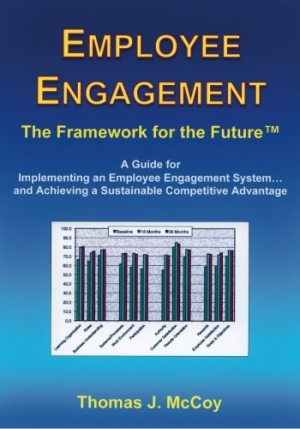Employee Engagement
It is hardly accidental that successful companies know how to motivate their employees to work toward a common goal. Creating an environment that fosters employee engagement is the subject of Thomas McCoy’s comprehensive and well-written book, Employee Engagement. McCoy, who founded The Employee Engagement Institute, shares a system he calls “The Framework for the Future,” which is based on his nearly two decades of experience in the field.
McCoy begins with an overview of “the partnership model,” a model he believes is essential to follow for employee engagement to work productively. He shows the interrelationship between an organization’s managers, employees, and customers, suggesting that “the most effective way employees can address customer expectations is to think and act like business partners.” This concept establishes the basis for the notion of employee engagement.
McCoy then proceeds to describe the employee engagement system in exhaustive detail. He covers how to design the system, build the system, and implement the system. Numerous charts, diagrams, and illustrations enhance the text.
The author makes extensive use of a variety of tools and techniques to facilitate development and implementation; he provides “templates” (detailed lists of system components), “sessions” (thorough descriptions of interactive meetings), and “tools” (documents that assist in implementation). One of the tools he provides is the VALUE Assessment. “VALUE is an acronym for the leadership skills and behaviors that support change,” writes the author, noting what it stands for: visible, active, long-term, unconditional, educator. McCoy provides guidance for exactly how to employ the VALUE process and a template for implementing the VALUE Assessment.
One of the more intriguing chapters, “The Empowerment Process,” addresses the need for management to surrender partial control of the business to employees. The author argues that empowerment “is one of the most difficult and essential elements for developing a high-involvement, high-performance workforce.” He claims that many organizations never really do empower their employees and describes this as “a fatal mistake that kills engagement.”
McCoy’s concluding chapter, “Phase II—Sustaining Change,” illustrates how one company used employee engagement to make positive changes and, in the process, identified five systemic issues that required refinement. These issues became the focus of the second phase of engagement activities. With the Phase II example, the author includes an implementation map, budget template, and sample implementation schedule.
Employee Engagement is a blueprint for creating and executing an employee engagement system from start to finish. It should be of great value to any business owner or senior executive who wants to maximize the involvement of the company’s most valuable asset.
Reviewed by
Barry Silverstein
Disclosure: This article is not an endorsement, but a review. The publisher of this book provided free copies of the book and paid a small fee to have their book reviewed by a professional reviewer. Foreword Reviews and Clarion Reviews make no guarantee that the publisher will receive a positive review. Foreword Magazine, Inc. is disclosing this in accordance with the Federal Trade Commission’s 16 CFR, Part 255.

